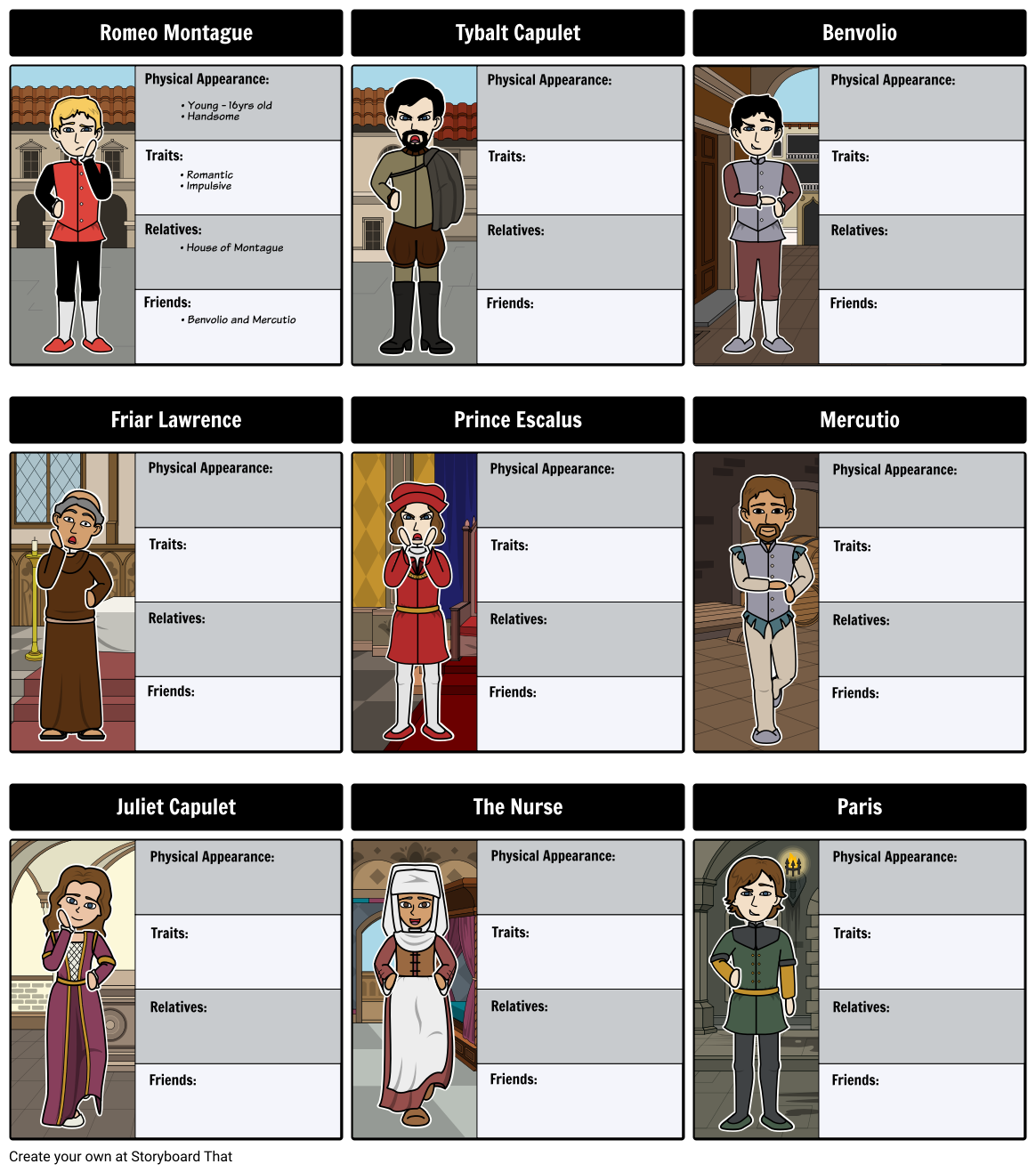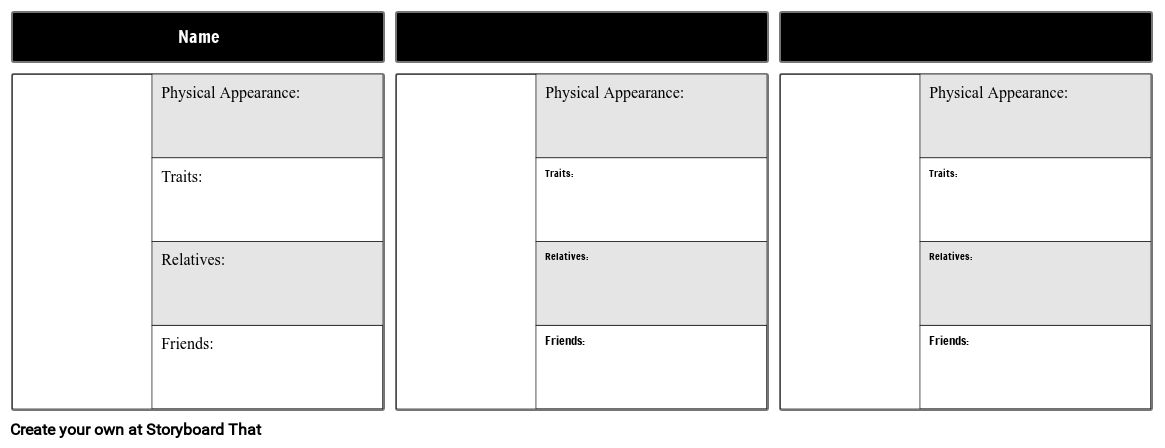Lesson Plan Overview
As students read, a storyboard can serve as a helpful character reference log. This log (also called a character map) allows students to recall relevant information about important characters. When reading a play, small attributes and details frequently become important as the plot progresses. With character mapping, students will record this information, helping them follow along and catch the subtleties which make reading more enjoyable!
Using a character map for Shakespeare is often even more beneficial. It also allows students to record the nuances of characteristics which create "foil" characters. The information that they record will help them to return and review personalities that contrast. The ability to visually see this helps students create connections and makes understanding concepts easier.
Copying the assignment to your account will give you both the example above and a blank template you can customize as desired. Feel free to use it as is, or to edit it for the level of your class. Printing it as worksheets for your students to complete while reading is a fast and easy way to incorporate this character map into your classroom.
Template and Class Instructions
(These instructions are completely customizable. After clicking "Copy Activity", update the instructions on the Edit Tab of the assignment.)
Student Instructions
- Click "Start Assignment".
- Identify the major characters in Romeo and Juliet and type their names into the different title boxes.
- Choose a character from the "Medieval" tab to represent each of the literary characters.
- Select colors and a pose appropriate to story and character traits.
- Choose a scene or background that makes sense for the character.
- Fill in the text boxes for Physical Characteristics, Traits, Relatives (Capulet/Montague/Other), and Friends.
Lesson Plan Reference
Student Rubric
(You can also create your own on Quick Rubric.)
| Proficient 33 Points | Emerging 25 Points | Beginning 17 Points | |
|---|---|---|---|
| Character Picture & Scene | The characters and scenes are both appropriate for the book's characters. | Many of the characters and scenes match the book's characters. | More than half of the characters and scenes do not match the characters in the book. |
| Accuracy of Notes | Most of the information of the notes is correct. | Many of the notes have correct information, but some are incorrect or missing. | Less than half of the information of the notes is correct and relevant. |
| Effort | Work is complete, thorough, and neat. | Most of the sections of the character map were at least attempted and work is presentable. | Character map is unfinished and/or disorganized. |
Lesson Plan Overview
As students read, a storyboard can serve as a helpful character reference log. This log (also called a character map) allows students to recall relevant information about important characters. When reading a play, small attributes and details frequently become important as the plot progresses. With character mapping, students will record this information, helping them follow along and catch the subtleties which make reading more enjoyable!
Using a character map for Shakespeare is often even more beneficial. It also allows students to record the nuances of characteristics which create "foil" characters. The information that they record will help them to return and review personalities that contrast. The ability to visually see this helps students create connections and makes understanding concepts easier.
Copying the assignment to your account will give you both the example above and a blank template you can customize as desired. Feel free to use it as is, or to edit it for the level of your class. Printing it as worksheets for your students to complete while reading is a fast and easy way to incorporate this character map into your classroom.
Template and Class Instructions
(These instructions are completely customizable. After clicking "Copy Activity", update the instructions on the Edit Tab of the assignment.)
Student Instructions
- Click "Start Assignment".
- Identify the major characters in Romeo and Juliet and type their names into the different title boxes.
- Choose a character from the "Medieval" tab to represent each of the literary characters.
- Select colors and a pose appropriate to story and character traits.
- Choose a scene or background that makes sense for the character.
- Fill in the text boxes for Physical Characteristics, Traits, Relatives (Capulet/Montague/Other), and Friends.
Lesson Plan Reference
Student Rubric
(You can also create your own on Quick Rubric.)
| Proficient 33 Points | Emerging 25 Points | Beginning 17 Points | |
|---|---|---|---|
| Character Picture & Scene | The characters and scenes are both appropriate for the book's characters. | Many of the characters and scenes match the book's characters. | More than half of the characters and scenes do not match the characters in the book. |
| Accuracy of Notes | Most of the information of the notes is correct. | Many of the notes have correct information, but some are incorrect or missing. | Less than half of the information of the notes is correct and relevant. |
| Effort | Work is complete, thorough, and neat. | Most of the sections of the character map were at least attempted and work is presentable. | Character map is unfinished and/or disorganized. |
How to Teach Tragic Hero Motifs and Archetypes
Introduction to Tragic Hero Motifs and Archetypes
Begin by defining the terms "tragic hero," "motif," and "archetype." Provide an overview of the characteristics that define a tragic hero, such as noble birth, tragic flaw, and reversal of fortune. Explain how tragic hero motifs and archetypes appear in literature and drama.
Analyzing Romeo as a Tragic Hero
Focus on Romeo's character in "Romeo and Juliet" and guide students in analyzing how he embodies the characteristics of a tragic hero. Encourage students to reference specific scenes, actions, and decisions that highlight Romeo's tragic hero status. Discuss how Romeo's character aligns with the classical tragic hero archetype.
Comparative Analysis of Tragic Heroes
Present students with examples of tragic heroes from other literary works or drama. Engage students in a comparative analysis, exploring how these characters share or differ from the tragic hero archetype. Discuss the concept of universality in tragic hero motifs and archetypes.
Creative Writing and Presentation
Assign a creative writing project where students create a modern interpretation of a tragic hero. Provide guidelines for the project, including the incorporation of key tragic hero motifs and archetypes. Explain the presentation format for sharing their modern tragic hero stories.
Frequently Asked Questions about Main Characters in Romeo and Juliet
What are the key characteristics that define Romeo and Juliet as the main protagonists of the play?
Romeo and Juliet are defined as the main protagonists of the play due to several key characteristics. They are young, passionate, and impulsive, representing the idealism of youth. Their love defies societal norms and familial conflicts, making them emblematic of love's power to transcend barriers. Their profound love for one another drives the plot, leading to the tragedy. Their characters embody themes of love, fate, and the consequences of conflict, making them central to the narrative.
In what ways does the character of Mercutio add depth and complexity to the story, and how does his death affect the main characters?
Mercutio is a dynamic character who brings wit, humor, and levity to the play. His sharp wordplay and unconventional thinking add a layer of complexity to the story, providing a contrast to the intense love of Romeo and Juliet. Mercutio's death, however, marks a pivotal turning point. It results in a tragic shift from comedy to profound sorrow, impacting the main characters significantly. His demise prompts Romeo to take vengeful action against Tybalt, ultimately leading to the tragic culmination of events.
What are some best practices for using storyboards and worksheets to explore the psychological and emotional dimensions of the main characters and their responses to the unfolding events in the play?
Using storyboards and worksheets to delve into the psychological and emotional dimensions of the main characters in "Romeo and Juliet" requires thoughtful implementation. Best practices include encouraging students to create visual depictions of key scenes that capture the characters' emotions, using worksheets as character diaries to express characters' thoughts and feelings, analyzing dialogues for underlying emotions, building empathy by putting themselves in the characters' shoes, and promoting group discussions and reflections after completing activities. These practices foster a deeper understanding of the characters' emotional journeys and their responses to the unfolding events, enhancing students' connection to the play's themes and narrative.
More Storyboard That Activities
Tragedy of Romeo and Juliet
This Activity is Part of Many Teacher Guides
Testimonials

“By using the product, they were so excited and they learned so much...”–K-5 Librarian and Instructinal Technology Teacher

“I'm doing a Napoleon timeline and I'm having [students] determine whether or not Napoleon was a good guy or a bad guy or somewhere in between.”–History and Special Ed Teacher

“Students get to be creative with Storyboard That and there's so many visuals for them to pick from... It makes it really accessible for all students in the class.”–Third Grade Teacher
© 2026 - Clever Prototypes, LLC - All rights reserved.
StoryboardThat is a trademark of Clever Prototypes, LLC, and Registered in U.S. Patent and Trademark Office











